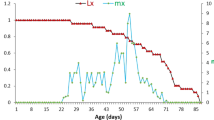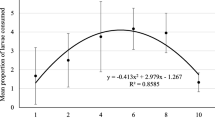Abstract
A per capita model for the growth, development and reproduction of the coccinellid predatorRhizobius lophanthae (Blaisd) feeding on the oleander scale(Aspidiotus nerii Bouche (Homoptera: Diaspididae)) was developed. A thermal threshold for development of 9.4°C was found. Under conditions of unlimited food, the relationship of mass at time t + 1 to that at t (in days at 25°C) suggests an 8.7 percent growth rate per mg larvae per day at 25°C. An adult female beetle produces approximately 20 eggs per day while consuming an average of 8.5 scales/day. This is approximately 2.16 eggs per scale consumed above the maintenance level of 1.88 scales per day. More precisely, this compensation point is 0.12 mg of prey/mg of predator/day at 25°C and the egestion rate is 1 - β = 0.63
Résumé
Un modèle par individu de la croissance, du développement et de la reproduction deRhizobius lophantae Biais., coccinelle prédatrice de la cochenille du laurier rose(Aspidiotus nerii Bouché) (Horn.: Diaspididae) a été élaboré. Un seuil théorique de développement thermique de 9,4°C a été déterminé. Dans des conditions de nourriture non limitantes, la relation de la masse au temps t + 1 à la masse au temps t (en jours à 25°C) se traduit par un taux de croissance de 8,7% par mg de larve/jour à 25°C. Une femelle adulte du prédateur produit approximativement 20 æufs/jour alors qu’elle consomme une moyenne de 8,5 cochenilles/jour. Ceci représente 2,16 æufs par cochenille consommée en plus du niveau d’entretien de 1,88 cochenilles par jour. Plus précisément, ce point de compensation est de 0,12 mg/ mg de proie/ jour à 25°C et le taux d’excrétion est de 1 - β = 0,63
Similar content being viewed by others
References
Baumgärtner, J., Bieri, M. &Delucchi, V. 1987. Growth and development of immature life stages ofPropylaea 14-punctata L. andCoccinella 7-punctata L. (Col.: Coccinellidae) simulated by the metabolic pool model. -Entomophaga, 32, 415–423.
Da Silva, P. G., Hagen, K. S. &Gutierrez, A. P. 1992. Functional response ofCurinus coeruleus (Col.: Coccinellidae) toHetewpsylla cubana (Horn.: Psyllidae) on artificial and natural substrates. -Entomophaga, 37, 555–564.
Delucchi, V., Baumgärtner, J. &Bieri, M. - 1983. An integrated control approach for canning pea crop pests in Switzerland. -Proc. 10th Intern. Congr. Plant Protection, Brighton, England, 3, 1188.
Frazer, B.D. &Gilbert, N. - 1976. Coccinellids and aphids: a quantitative study of the impact of adult ladybirds (Coleoptera: Coccinellidae) preying on field populations of pea aphids (Homoptera: Aphididae). -J. Entomol. Soc. Brit. Columbia., 73, 33–56.
Greathead, D. J. - 1973. A review of introductions ofLindorus lophanthae (Blaisd.) (Col.: Coccinellidae) against hard scales (Diaspididae). -C.I.B.C. Tech. Bull., 16, 29–33.
Gutierrez, A. P., Baumgärtner, J. U. &Hagen, K. S. - 1981. A conceptual model for growth, development, and reproduction in the ladybird beetle,Hippodamia convergens (Coleptera: Coccinellidae). -Can. Ent., 113, 21–33.
Gutierrez, A. P., Baumgärtner, J. U. &Summers, C. G. - 1984. Multitrophic models of predator-prey energetics. -Can. Ent., 116, 923–963.
Gutierrez, A. P., Mills, S. J., Schreiber, S. J. &Ellis, C. K. - 1994. A physiologically based tri trophic perspective on bottom up-top down regulation of populations. -Ecology, 75, 2227–2242.
Inger-Johanne, E. - 1969. Fecundity, aphid consumption and survival of the aphid predatorActalia bipunctata L. (Col.: Coccinellidae). -Norw. J. Entomol., 16, 91–95.
Marin, R. - 1983. Biologia y capacidad de predaciön deLindorus lophanthae (Biais) (Col.: Coccinellidae) predator dePinnaspis aspidistrae (Sing.) (Horn.: Diaspididae). -Revista peruana de entomologia, 26, 63–66.
Pizzamiglio, M. A. - 1985. Population studies onAspidiotus nerii Bouché (Homoptera: Diaspididae) and two of its natural enemies on California Bay Trees. Berkeley. 96 p. (Master in Science — Graduate Division/ University of California, Berkeley-USA).
Author information
Authors and Affiliations
Rights and permissions
About this article
Cite this article
Cividanes, F.J., Gutierrez, A.P. Modeling the age-specific per capita growth and reproduction ofRhizobius lophanthae (Col: Coccinellidae). Entomophaga 41, 257–266 (1996). https://doi.org/10.1007/BF02764251
Received:
Accepted:
Published:
Issue Date:
DOI: https://doi.org/10.1007/BF02764251




